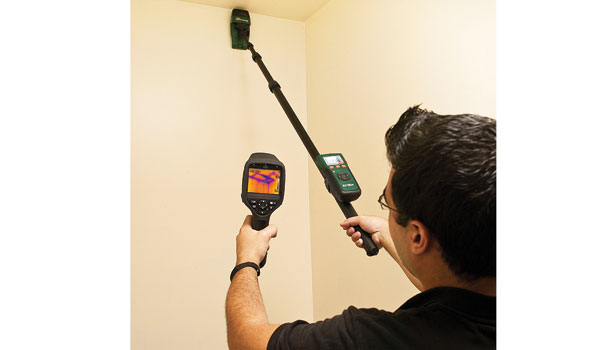IR Cameras: Revolutionary for Restoration Work


Infrared cameras have been revolutionary for our industry in many ways. It is a quick and effective tool to help determine what is wet, how wet and whether the wet material is drying. But the technology shouldn’t be used without confirming the presence of water with moisture meters due to the fact that thermal imaging devices work by measuring temperature. Thermal imaging operates along the lines of traditional cameras, except instead of capturing visible reflected light, thermal imaging cameras detect heat released from an object. Evaporation from wet surfaces causes a cooling effect – therefore differences in temperature create a pattern that is processed by the device.
Anytime something comes along that fundamentally undermines the status quo of the disaster restoration industry there are the leaders who quickly adopt the new technology and others who take a wait-and-see approach. It’s been a long time since leaders in our industry began using the cameras and few restorers are waiting any longer, especially as prices have dropped dramatically.
Typically, a traditional water damage restoration project involves detecting and documenting wet material so that it can be properly dried. Usually restorers use penetrating, non-penetrating, insulated and non-insulated moisture meters to determine what needs to be dried. With thermal imaging, restorers can achieve the same results faster and often times with a higher degree of accuracy.
Thermal imaging has the potential to enhance drying for restorers who can quickly and accurately locate pockets of moisture. The cameras should be used to augment and confirm existing moisture meters. This technology has lead to a fundamental shift in the way we determine what material is wet and how accurately we document it, so certainly there will be people who benefit from it. However, just who benefits financially has sometimes been controversial. Should the restorer charge for using this device? Should an insurance carrier be required to pay for the detection device? Our company does not charge for using the camera, as we consider the detection an integral part of the documentation process which we are already being compensated for under monitoring. Having said that, I think you are going to find those who do charge a separate line item – although the trend appears to be to include it in monitoring charges.
Once I began using thermal imaging many years ago, it changed the basic paradigm of detecting potential trouble spots. After learning how to interpret the data, it became clear that I couldn’t conduct my job properly without one. One of the many advantages of utilizing a thermal imaging camera is the accuracy of moisture surveys. Another is time savings. I have found that even with the added cost of purchasing a camera, the return on investment (ROI) is very fast and credibility with your clients enhanced. As they say, a picture is worth a thousand words.
Thermal imaging devices have continued to come down in price while sensitivity and user-friendly features have evolved. Restorers need to understand how best to interpret the images on the viewer, which are really representations of temperature, that requires training and a level of expertise to avoid misinterpreting the data.
Today’s improvements in technology are a natural progression of our industry and have been ongoing since the day I began processing water damage losses. Thirty five years ago, restorers pronounced structures dry by any means at their disposal – often times with a moisture sensor. The disaster restoration industry, like many other professional endeavors, has evolved. Other than a device to determine the perimeter of wet carpet, the use of moisture sensors is mostly gone from the professional water restoration contractor’s toolbox. Today, we are evolving again and thermal imaging has found its way into our toolbox. I wouldn’t investigate a water-damaged building without it.
Check Out The Latest IR Cameras from Flir Here




